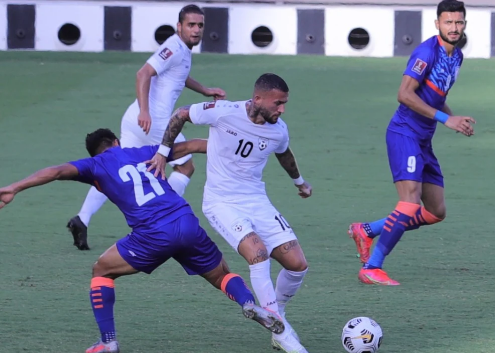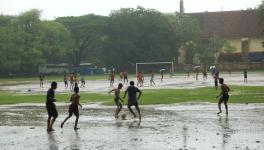Beat This: India Blame Afghanistan Players’ Pedigree for Poor Outing in FIFA World Cup Qualifier

Action for the Indian football team vs Afghanistan FIFA World Cup qualifier in Doha.
The season of excuses has begun. At the right earnest!
Minutes after India ended their 2022 FIFA World Cup qualifying campaign with a highly forgettable 1-1 draw against Afghanistan (ranked 44 places below India) and chief coach Igor Stimac decided to skip the post-match press conference, assistant coach Shanmugam Venkatesh was there to talk about the team’s performance.
Venkatesh, a former India captain and one of India’s finest midfielders in recent times, perhaps knew there was not much to talk about India’s show. Instead he spoke about how difficult it was to counter the rampaging Afghans. The reason for this, he said, was the presence of several footballers in the opposition who play professional club football outside Afghanistan. He, however, did not wait to explain that these players mostly play in lower division leagues in Germany, the US, Poland, Denmark, Sweden, Australia etc.
Also Read | Copa America: Brazil’s Supreme Court Allows Staging of Tournament Under Covid-19 Cloud
There is no reason to believe it was an off the cuff remark from India’s long-time assistant coach, who had earlier worked under Stephen Constantine. To put it bluntly, it was a simple ploy to divert attention and cover up the team’s rather poor performance. An old strategy used during the 2018 World Cup qualifiers too.
Remember the 2015 away game against Guam, then ranked 33 places below India? India suffered a humiliating 1-2 defeat against the tiny island nation and the then coach Constantine had his own theory behind the defeat.
“We are disappointed. Today the difference was very much visible between a group of players who have the best football education and the rest. Seventy-five per cent of the players who represented Guam have been born and brought up in the US and that made a huge difference,” said the British coach in his defence.
Anyone who tried to counter this theory and pointed out India played miserably against Guam that particular night, was brushed aside. Managing the headlines had been the national federation’s main focus of interest in the recent past. It succeeded in doing so after the Guam tie. Once India beat Guam in the home encounter, all talks of them having US-based players vanished conveniently!
In the match versus Afghanistan, it was India’s disappointing show that caused the anguish, not the rival players from minor leagues in Europe. Moreover, the theory that Afghanistan were a “difficult” side because they had footballers from foreign leagues only undermines the All India Football Federation’s (AIFF) own system.
How many times the Indian fans in the past few years have repeatedly been told that India are now running a top-tier domestic league that has reached the pinnacle of professionalism? How many times has it been pointed out that the jungle of foreign legs in Indian league is immensely adding to the strength of Indian players to match the best in international football? How can all the bravado suddenly evaporate in front of a bunch of youngsters, who mostly play in second or third divisions in some obscure European leagues? Does that mean our cash-rich league is actually not good enough to match those smaller competitions?
Also Read | Dingko Singh Obituary | Bravery, Brashness & Boxing, A Life Defined By Honest Toil
It sounds good to say India achieved the goal – they finished third in the group (E) and made the third round qualifiers for the AFC Asian Cup. But then, there is darkness under the lamp which always remains dark. In reality, India finished third in the most ungraceful manner – having just seven points in a relatively easy group.
Looking at the group after the draw was made, the fans were convinced India could return home with at least 12 points from the eight-match competition, if not more. The belief was further strengthened after the memorable goalless draw against Asian champions Qatar. To pick up four wins against Bangladesh and Afghanistan looked like the next goal. The dream was shattered in the first two matches against the two SAFF partners. There was hardly any improvement after the base shifted to Qatar.
Stimac and his men must be thanking their stars in private for being able to walk back with one point from the Afghanistan match. India were distinctly lucky to pick up the lead through a goal that was hardly there. What was even more distressing to see was they couldn’t hold on to the lead for more than seven minutes. Substitute Hossein Zamani, the 18-year-old forward, left the Indian defence stranded with a measured right footer. Well, the managers of Indian football at home can take pride from the fact that the teenager is actually a player from an Indian club though he never had a feel of pitch throughout the season.
Much was said about India’s ability to maintain the shape in defence and start the move from there ever since the Croatian coach took over. The defence did a good job in both matches against Qatar but no such thing was visible against Afghanistan. The goal against India was an ample example of how vulnerable their defence could be. Rahul Bheke was brought back to the squad after his one-match suspension, but the move hardly helped the team.
Also Read | Hoodoo Broken Thanks To Chhetri’s Inimitable Brilliance
Those who thought the inclusion of Brandon Fernandes and Glan Martins was the only silver lining in the midfield surely felt frustrated after the Afghanistan tie. India ended the Qatar leg with four points from two matches. They struck three goals – two coming from Sunil Chhetri and the other was an own goal. It doesn’t talk highly of India’s firepower. Overall, India finished with a negative goal difference.
Now the pre-World Cup campaign is over with just seven points on the table, the next stage is rather predictable. The hue and cry will be about whether the coach should once again be handed over the responsibility to manage the team in the Asian Cup qualifiers. Several ifs and buts are attached to it, especially after the AIFF technical committee granted Stimac an extension of only three months. If the decisions in the technical committee are to be believed, the coach is expected to give a report or tell the committee his side of the story by next month or so.
No doubt Stimac won’t have much to defend himself from on-field results except some cold statistics like the percentage of ball possession or the number of passes played by his players. He had dumped such figures before – it remains to be seen whether the committee remains convinced with it this time around.
There is one more thing. Stimac’s criticism of the arrangements made for India’s preparations in Qatar this month could seriously go against the coach getting an extension. The ad hoc body of the AIFF run by Praful Patel and his men (since elections are overdue for six months) were left embarrassed in front of Qatar FA by Stimac’s sudden outburst. Coaches in India are often shown the door for off-the-field reasons. Stimac too may find himself in a vulnerable position here.
Get the latest reports & analysis with people's perspective on Protests, movements & deep analytical videos, discussions of the current affairs in your Telegram app. Subscribe to NewsClick's Telegram channel & get Real-Time updates on stories, as they get published on our website.
























